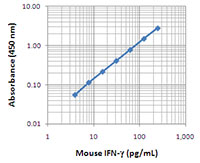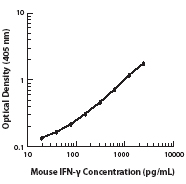- Clone
- R4-6A2 (See other available formats)
- Regulatory Status
- RUO
- Other Names
- Interferon-γ, Immune interferon, Type II interferon, T cell interferon, Macrophage-activating factor (MAF), IFN-g, IFN-gamma
- Isotype
- Rat IgG1, κ
- Ave. Rating
- Submit a Review
- Product Citations
- publications

| Cat # | Size | Price | Save |
|---|---|---|---|
| 505704 | 500 µg | ¥48,780 |
Interferon-γ is a potent multifunctional cytokine which is secreted primarily by activated NK cells and T cells. Originally characterized based on anti-viral activities, IFN-γ also exerts anti-proliferative, immunoregulatory, and proinflammatory activities. IFN-γ can upregulate MHC class I and II antigen expression by antigen-presenting cells.
Product DetailsProduct Details
- Reactivity
- Mouse
- Antibody Type
- Monoclonal
- Host Species
- Rat
- Immunogen
- Partially-purified, native mouse IFN-γ
- Formulation
- Phosphate-buffered solution, pH 7.2, containing 0.09% sodium azide.
- Preparation
- The antibody was purified by affinity chromatography, and conjugated with biotin under optimal conditions.
- Concentration
- 0.5 mg/ml
- Storage & Handling
- The antibody solution should be stored undiluted between 2°C and 8°C. Do not freeze.
- Application
-
ELISA Detection, ELISPOT Detection
- Recommended Usage
-
Each lot of this antibody is quality control tested by ELISA assay. For use as an ELISA detection antibody, a concentration range of 0.5-2.0 µg/ml is recommended. To obtain a linear standard curve, serial dilutions of IFN-γ recombinant protein (Cat. No. 575309) are recommended at concentration up to 2000 pg/mL. The final standard range should be determined by the end user.
For use as an ELISPOT detection antibody, a concentration range of 1-4 µg/ml is recommended. It is recommended that the reagent be titrated for optimal performance for each application. - Application Notes
-
ELISA Capture1-4,6,10,11 or ELISPOT Capture5: The purified R4-6A2 antibody is useful as the capture antibody in a sandwich ELISA or ELISPOT assay, when used in conjunction with the biotinylated XMG1.2 antibody (Cat. No. 505804) as the detecting antibody and recombinant mouse IFN-? (Cat. No. 575309) as the standard. The Ultra-LEAF™ purified antibody is suggested for ELISPOT capture. For ELISPOT Capture, the suggested use of this antibody is 1.0 - 4.0 µg/mL.
ELISA or ELISPOT Detection: The biotinylated R4-6A2 antibody is useful as the detecting antibody in a sandwich ELISA or ELISPOT assay, when used in conjunction with the purified XMG1.2 antibody (Cat. Nos. 505802 & 505812) as the capture antibody and recombinant mouse IFN-? (Cat. No. 575309) as the standard.
Neutralization1,2,9: The Ultra-LEAF™ purified antibody (Endotoxin <0.01 EU/µg, Azide-Free, 0.2 µm filtered) is recommended for neutralization of mouse IFN-? bioactivity in vivo and in vitro (Cat. Nos. 505708 - 505713).
Additional reported applications (for the relevant formats) include: immunohistochemical staining3,6,8 of acetone-fixed frozen tissue sections.
Note: For testing mouse IFN-? in serum, plasma or supernatant, BioLegend's ELISA Max™ Sets (Cat. No. 430801 and 430804) are specially developed and recommended. -
Application References
(PubMed link indicates BioLegend citation) -
- Abrams J, et al. 1992. Immunol. Rev. 127:5.
- Stevenson M, et al. 1990. Infect. Immun. 58:3225.
- Sander B, et al. 1993. J. Immunol. Meth. 166:201.
- Yang X, et al. 1993. J. Immunoassay 14:129.
- Klinman D, et al. 1994. Curr. Prot. Immunol.. John Wiley and Sons, New York. Unit 6.19.
- Sander B, et al. 1991. Immunol. Rev. 119:65.
- Finkelman F, et al. 2003. Curr. Prot. Immunol. John Wiley & Sons, New York. Unit 6.28.
- Khanna A, et al. 2000. J. Immunol. 164:1346.
- Terrazas LI, et al. 2005. Intl. J. Parasitology. 35:1349.
- Dzhagalov I, et al. 2007. J. Immunol. 178:2113.
- Xu G, et al. 2007. J. Immunol. 179:5358.
- Product Citations
- RRID
-
AB_315392 (BioLegend Cat. No. 505704)
Antigen Details
- Structure
- Cytokine; dimer; 40-80 kD (Mammalian)
- Bioactivity
- Antiviral/antiparasitic activities; inhibits proliferation; enhances MHC class I and II expression on APC
- Cell Sources
- CD8+ and CD4+ T cells, NK cells
- Cell Targets
- T cells, B cells, macrophages, NK cells, endothelial cells, fibroblasts
- Receptors
- IFN-γRα (CDw119) dimerized with IFN-γRβ (AF-1)
- Cell Type
- Tregs
- Biology Area
- Cell Biology, Immunology, Neuroinflammation, Neuroscience
- Molecular Family
- Cytokines/Chemokines
- Antigen References
-
- Fitzgerald K, et al. Eds. 2001. The Cytokine FactsBook. Academic Press, San Diego.
- De Maeyer E, et al. 1992. Curr. Opin. Immunol. 4:321.
- Farrar M, et al. 1993. Annu. Rev. Immunol. 11:571.
- Gray P, et al. 1987. Lymphokines 13:151.
- Regulation
- Upregulated by IL-2, FGF-basic, EGF; downregulated by 1-α-25-Dihydroxy vitamin D3, dexamethasone
- Gene ID
- 15978 View all products for this Gene ID
- UniProt
- View information about IFN-gamma on UniProt.org
Related FAQs
- How many biotin molecules are per antibody structure?
- We don't routinely measure the number of biotins with our antibody products but the number of biotin molecules range from 3-6 molecules per antibody.
Customers Also Purchased



Compare Data Across All Formats
This data display is provided for general comparisons between formats.
Your actual data may vary due to variations in samples, target cells, instruments and their settings, staining conditions, and other factors.
If you need assistance with selecting the best format contact our expert technical support team.












Follow Us